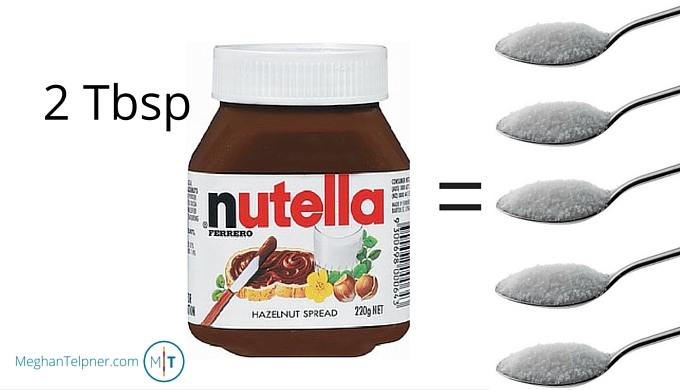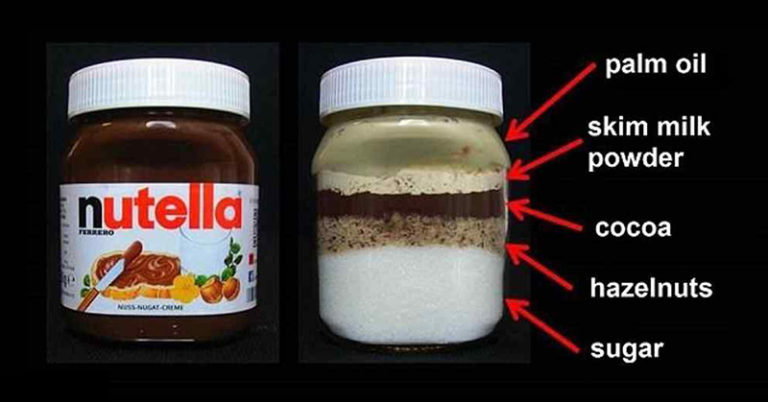Nutella is beloved around the world, and has such a die-hard fanbase that it’s reached near cult-like status. Parents have tried to name their kids after the chocolatey spread, people have invented locks to prevent others from breaking into their stash, and in 2018, “Nutella Riots” spread across France when one supermarket chain put it on sale 70% off. Aside from being a tasty, creamy, chocolatey spread, Nutella is advertised as being part of a healthy, balanced breakfast. As is so often the case, however, this is another “too good to be true” moment. At the risk of causing mass devastation across the country, we’re sorry to report that the main Nutella Ingredients are in no way healthy or balanced.
What is Nutella?
Quite simply, Nutella is a creamy chocolate spread, but its history is far more interesting.
The story of the beloved spread began in 1806 at the height of the Napoleonic Wars. The French Emperor set up a continental blockade that cut off access to the Piedmont region of Italy and made trade extremely difficult. It is worth noting that at the time, this region was known to produce the finest chocolate in the world.
Because of high demand and low supply, however, cocoa prices went through the roof, and chocolatiers in the region began adding hazelnuts, which were plentiful in the area, to their chocolate to make their supply last a little longer.
It Wasn’t Always Called Nutella
This product became known as gianduja. Once the war ended, however, and chocolate became more accessible again, most chocolatiers ditched the hazelnuts and returned to making the pure stuff.
It wasn’t until the second World War when food rationing made chocolate wildly expensive and nearly impossible to find. It was then that an Italian pastry maker named Pietro Ferrero (yes, that Ferrero) created a paste that was made primarily of blended hazelnuts and a touch of chocolate.
He named his product past gianduja, wrapped it in foil, and distributed it in the streets. Its thick consistency made it ideal cutting into loaf-like slices and putting between two slices of bread to make a sandwich.
Pietro decided he wanted to improve the recipe by making it creamier and more spreadable and changed the name to supercrema gianduja. It wasn’t until 1964 that the name changed to Nutella, and it has been a staple in Italy ever since.
The spread was originally meant as a treat, but its popularity among children was an easy way to get them to eat bread, which provided more nutrition than the chocolate spread alone. For this reason Nutella gradually became accepted as breakfast food.
Today’s Nutella recipe, however, is a far cry from the original recipe of the 1940s, and combined with the standard white bread many kids eat today, it likely does more nutritional harm than good.
Four Reasons to Avoid Nutella

Nutella has five main ingredients: palm oil, skim milk powder, cocoa, hazelnuts, and sugar. When you begin to look at these components more closely, it becomes obvious why you want to keep the stuff off of your breakfast table. Let’s do a breakdown of the Nutella Ingredients:
1. Palm Oil
Palm oil is a vegetable oil that comes from the fruit of the palm tree Elaeis guineensis. It is a low-quality, cheap-to-produce oil that is high in saturated fat and is used in everything from foods to cosmetics to biofuels.
Palm oil has been flagged by the European Food Safety Authority (EFSA) as dangerous because it can cause cancer when processed at high temperatures [2].
This is because of glycidyl fatty acid esters (GE) form when palm oil is heated, which have been found to be both genotoxic and carcinogenic in animal studies. Different models have been used to assess human cancer risk based on these studies, and have concluded that there is a health concern associated with GE [3].
Additionally, its high saturated fat content poses additional health risks, including cardiovascular disease (CVD). Diets high in saturated fat have been linked to CVD, and the American Heart Association recommends that you limit your intake of this type of fat in favor of polyunsaturated fats [4].
Environmentally, palm oil is a disaster and is the largest driver of deforestation in Indonesia. This is destroying animal habitats and thus biodiversity, and contributing to climate change in a significant way. On top of that, waste ponds at palm oil refineries release massive amounts of methane gas, a greenhouse gas that is 34 times more potent than carbon dioxide [5].
2. Sugar
Sugar, by weight, is the most prominent ingredient in Nutella. One fifteen-gram tablespoon of the spread contains 8.5 grams of sugar, which equates to 227.2 grams in one 400-gram jar. Yes- that means that more than half the weight of Nutella comes from sugar alone [6].
According to the Nutella label, one 37-gram serving contains 21 grams of sugar, which means you’re spreading the equivalent of half a bottle of Coke on your toast in the morning [7].
Diets high in sugar have been proven to cause higher blood pressure, inflammation, weight gain, and fatty liver disease, all of which are linked to an increased risk for heart attack and stroke [8].
“Basically, the higher the intake of added sugar, the higher the risk for heart disease,” says Dr. Frank Hu, professor of nutrition at the Harvard T.H. Chan School of Public Health [8].

3. Cocoa vs. Cacao
Some may argue that the chocolate in Nutella provides some nutritional value, however, this claim may be a stretch. The problem? The majority of studies that have looked at the health benefits of chocolate were focused on the cacao beans themselves. This is different from the chocolate you typically find in stores.
Raw, minimally processed cacao beans provide a host of nutritional benefits including providing antioxidants, boosting your mood, lowering your blood pressure, and regulating your insulin levels.
To make cocoa (not cacao), however, the beans are heated to a much higher temperature, which destroys some of their nutritional content. It’s not that cocoa is necessarily bad for you, but it does not provide near the health benefits found in minimally-processed cacao.
4. Part of a “balanced breakfast”.
After receiving backlash for the health content of its product, Ferrero’s Nutella Manufacturers released the following statement:
“One of Ferrero’s core nutritional beliefs is that small portion sizes help people to enjoy their favourite foods in moderation. The labelling on our products enables consumers to make informed choices and helps ensure that Nutella can be enjoyed as part of a balanced diet.” [6]
While this may be true, the issue is that more often than not, the “balanced breakfast” in which Nutella is often included consists of things like pancakes, crepes, or white bread, which provide little nutritional benefit and typically contribute even more sugar and saturated fat.
Additionally, if you’re spreading generous amounts of Nutella on your toast every morning, this doesn’t really qualify as enjoying the product “in moderation”, as the company suggests. The bottom line? Ingredients in Nutella just aren’t that great.
Are There Alternatives to Nutella?
If you’re fretting about having to give up your favorite spread or morning staple, all is not lost. Avoiding Nutella’s ingredients isn’t hard. There are other alternatives out there that taste delicious but are made without all the palm oil and refined sugar.
One example is Artisana Organics Hazelnut Cacao Spread. It contains no palm oil, is dairy-free, and is made with coconut sugar, which is far less processed than the white stuff. Other options include Pyure Organic Hazelnut Spread, Savor Organic Hazelnut and Chocolate Spread, and Nuts.com Chocolate Hazelnut Butter.
Another way to enjoy the taste of Nutella without the undesirable ingredients is to make it yourself. There are many recipes for healthy Nutella alternatives out there, including this one from meghantelpner.com:
The ‘Better Than Nutella’ Hemp Chocolate Spread
Ingredients
- ¼ cup hemp seeds
- ⅓ cup raw cacao
- ¼ cup dry roasted hazenuts (omit for nut-free)
- ¼ cup ghee or coconut oil
- 2 tbsp honey
- pinch of sea salt
Directions
- Process all ingredients together until smooth.
- Add more sweetener as desired to taste.
Yes, You Can Still Enjoy Treats
Does all this mean that you have to give up Nutella forever? Not necessarily. It is important to remember that no one food is bad for you when it is eaten in moderation, and that some foods, such as Nutella, should be moderated perhaps more than others.
Calories are important, so are the nutrients that those calories provide. It’s important to make sure those calories count as much as possible. Nutella can have an occasional place in your diet, but should not be consumed regularly. However, if you decide to eliminate it altogether, you won’t be the worse for it.
For Dessert- Not Breakfast
This chocolatey spread managed to work its way into the breakfast conversation. In reality, it is best left at the dessert table. There are many breakfast options available that are better for you and better for the planet. While they may not be a creamy chocolate spread, they’re pretty delicious in their own right.
Sources
- ‘Process contaminants in vegetable oils and foods’ EFSA Published May 3, 2016.
- ‘Internal Doses of Glycidol in Children and Estimation of Associated Cancer Risk’ Pubmed Jenny Aasa et al. Published March, 2019.
- ‘Dietary Fats and Cardiovascular Disease: A Presidential Advisory From the American Heart Association’ AHA Journals Frank M. Sacks et al. Published June 15, 2017.
- ‘HOW DID PALM OIL BECOME SUCH A PROBLEM — AND WHAT CAN WE DO ABOUT IT?’ Ensia Michael Kodas Published November 3, 2014.
- ‘One spread, different ways to share it’ Nutella
- ‘The sweet danger of sugar’ Harvard Health. Published November 5, 2019.

